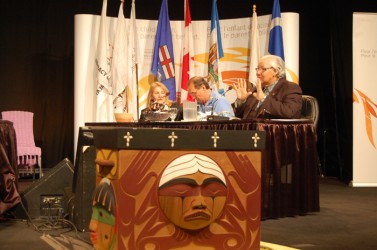Article Origin
Volume
Issue
Year
As the Truth and Reconciliation Commission draws to a close, it is in front of the courts again on one of the more contentious issues it has faced in its six years.
The TRC is asking the court to rule on what is to become of government and church documents that are not yet in the commission’s possession.
“The biggest challenge we faced was to get the parties to provide us with the documents they were obligated to give to us,” said TRC Chair Justice Murray Sinclair.
The Indian Residential School Settlement Agreement, signed in 2006, calls for the Anglican, Presbyterian and United Churches, the Catholic entities, and the federal government to provide all residential school-related documents to the TRC. However, the time and resources it would take to collect the documents caused the Anglican Church and the Catholic entities to balk, delaying their collection of materials.
The federal government refused to hand over all its relevant documentation, saying TRC personnel could search the archives. But a number of court decisions sought by the TRC resulted in the parties being ordered to undertake the work themselves and provide the material.
Sinclair says the lack of cooperation was mostly due to the costs involved in going through archives, but also partially due to the desire to keep the documentation quiet. He anticipates there are millions of documents yet to be collected.
“The parties may be able to resolve it among themselves, and tell the courts. But we need to have a logical answer and the logical answer is to continue to deliver the documents directly to the National Centre for Truth and Reconciliation,” said Sinclair.
The national centre, based at the University of Manitoba, is to house the documents collected by the TRC, as well as survivors’ statements and the gifts laid in the Bentwood box at various events. The TRC is hoping to hand over its anticipated $1 million surplus to the national centre, but that is another issue that needs to be dealt with. The TRC was created as a government department to allow funds and authority to flow, but that has presented a challenge in winding down its work.
“What we’ve learned is that nobody really knows how to close down a government department because they don’t do that. They merge departments. They can’t merge the commission with another government department because the commission was created by the settlement agreement,” said Sinclair.
But perhaps the greatest test facing the commission has been to accomplish its goals in the tight timeline, even with an additional year on its mandate
The TRC began its tumultuous ride in 2008 when the initial set of commissioners resigned within the first year. In 2009, Sinclair was appointed as new chair of the TRC and Chief Wilton Littlechild and Marie Wilson joined him. The trio had to spend valuable time building credibility with residential school survivors, says Sinclair.
“I think it proved to be a learning experience for everybody about how reconciliation could work. Because by the time we held our final national events, survivors themselves were not talking critically about the commission. They were speaking critically about the government, about the churches, about those members of Canadian society who continued to refuse to believe that what they say happened did happen,” said Sinclair. “They came to sense and look to the commission to be their public voice and their mirror for Canada to look into. So it was, at the end of the day, a very beneficial process that we all engaged in.”
The TRC was also tasked with making Canadians understand that the government and a number of churches had practised cultural genocide.
“It was a difficult conversation to accuse a nation of attempting to obliterate a race of people within their borders, particularly when Canada has such a generous view of itself and that generous view overlooks the way that Aboriginal people have been treated in this country. And for Canada to be told that the generosity of their self-absorption was not merited, was a real slap in the face and a shock to many people,” said Sinclair.
But once the stories started being told and the Prime Minister’s apology in 2008 was taken into consideration, Canadians began to understand that a people’s culture, language, and way of life had been deliberately targeted, he says.
In looking back on the settlement agreement and the years that have followed, Sinclair believes the parties to the agreement did not fully grasp how long it would take to build reconciliation.
“I think people had a basic misunderstanding of what reconciliation was about, what it entailed. There seemed to be a view that a process of reconciliation could be achieved within the lifetime of the commission and therefore once the commission finished everything was going to be all good and well and things we’re going to move forward,” he said.
But residential schools were in place for seven generations and seven years of a commission will not resolve the issues. It is up to the Canadian public to continue the work started by the TRC.
“The question is, ‘Are you committed enough to do something about it?’ And that’s what we want people to focus on,” said Sinclair.
Photo caption: Truth and Reconciliation Commission Chair Justice Murray Sinclair (right) is joined by commissioners Marie Wilson (left) and Chief Wilton Littlechild at the national event held in Edmonton in March 2014. In front of them is the Bentwood box.
- 1741 views

